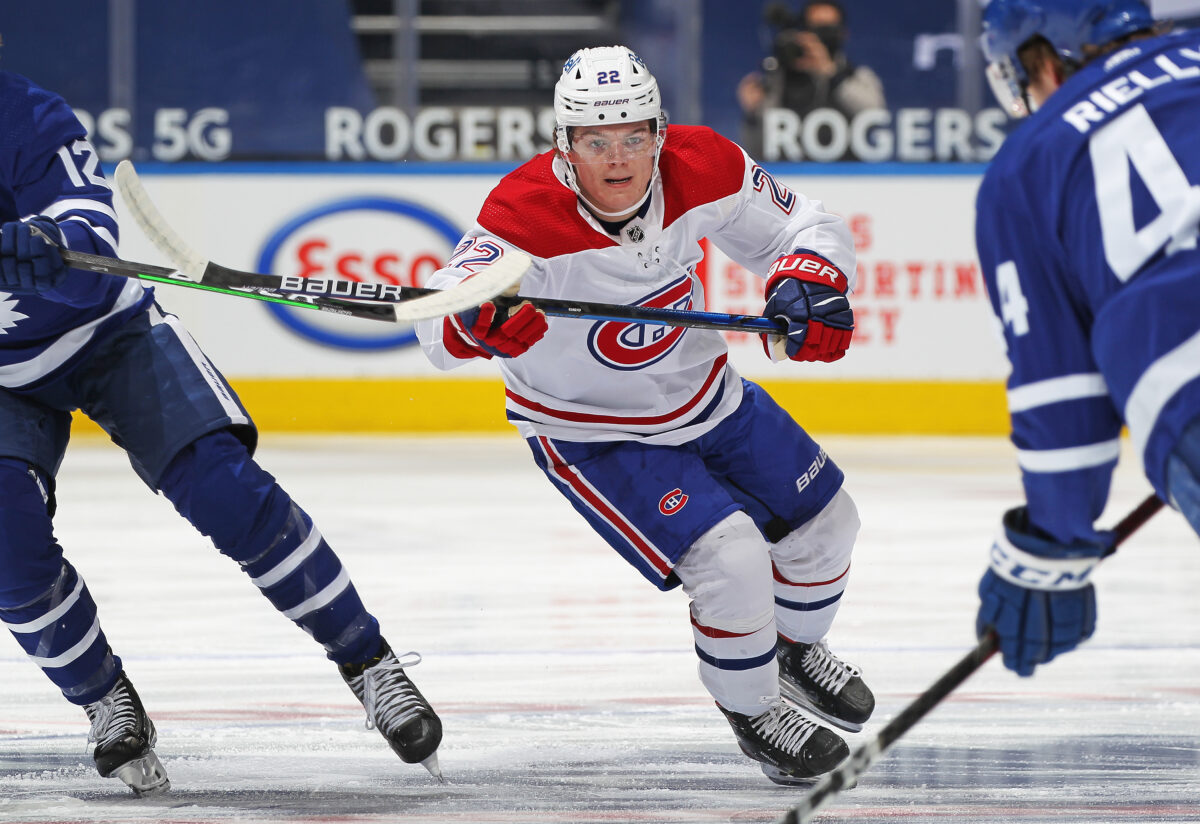Montreal Canadiens forward Paul Byron has long since cemented his spot in Habs lore as one of the best waiver-wire pickups in team history. Nothing is for certain at this stage, but, claimed earlier this season, Rem Pitlick at the very least has a chance to eclipse him.

True, Byron’s current contract is working against him here, but, for a time, he was one of the bigger bargains in the entire league as a two-time 20-goal scorer. How impressive has Pitlick been? With 11 goals so far this season (41 games), he’d be on pace to equal Byron’s career-high 22, set in 2016-17, over a complete season.
Pitlick Leading Caufield in Calder Scoring
More significantly, Pitlick’s only 25. Byron was no graybeard at age 28 to be fair, but it just points to Pitlick perhaps having higher to go and just scratching the surface of his potential, especially considering officially speaking he’s still a rookie… and outscoring teammate and one-time Calder Memorial Trophy-favorite Cole Caufield in the process, albeit by a single point.
Now, for the reality-check portion of this piece. Pitlick is not more valuable than Caufield. Not by a long shot. However, it further speaks to effectiveness as a function of age, with Caufield just having turned 21, and how Pitlick may very well end up the next Byron. Or, perhaps more optimistically, give the Habs a do-over in that regard.

Remember the days of Byron playing center beside Max Pacioretty (at the expense of Alex Galchenyuk) (from ‘Alex Galchenyuk refuses to close the door on moving back to the middle,’ The Athletic, Apr. 4, 2018)? Yeah, that’s not Pitlick. Nor should it have really been Byron, but the argument is Pitlick is not necessarily a top-six forward.
Byron was obviously an asset (and still is in certain respects, especially on the penalty kill), but his most productive seasons with the Canadiens? From 2016-18 he played the most with Tomas Plekanec and Brendan Gallagher, in what was essentially a top-six role, with Gallagher leading the team in scoring in 2017-18 (with a modest 54 points). That was the season the Canadiens finished in 28th place in the standings and drafted Jesperi Kotkaniemi, for added context.
All due respect to Byron, him playing the role he did that season in particular is a reflection of why the team finished where it did. It also gives some insight into why he was as prolific as he was and insight into where he and Pitlick diverge.
Pitlick Family Reunion on Canadiens
With the Canadiens, Pitlick’s played the most on a line centered by Jake Evans, with the duo splitting time with Josh Anderson and Artturi Lehkonen. While both of the latter two players have been productive recently, having them play deeper in the lineup is arguably a longer-term key to success. Ditto for Pitlick.
Keep in mind, Pitlick’s been as productive as he has been with 16:10 of ice time per game, out of the top six. That doesn’t necessarily mean he’ll produce more with more ice time, though. Consider how he got only 9:43 per game with the Minnesota Wild earlier this season. He still managed to score six goals (one more than he has the Habs) and five assists in 20 games (one fewer game than with the Habs).
So, strictly speaking, Pitlick’s been less productive with the Canadiens than he was with the Wild. As a result, giving Pitlick more ice time is not the answer. The stats just serve to reinforce the notion he is no mere flash in the pan.
A third-round draft pick by the Nashville Predators (No. 76 in 2016), who was similarly claimed off waivers by the Wild to start the season, he’s somewhat of a late-bloomer. This could be just the environment he needs to succeed, with his brother Rhett having been drafted by the Canadiens in 2019 (No. 131)… and, yes, his cousin Tyler having just been acquired in the Tyler Toffoli trade, admittedly as little more than a temporary body to fill a hole.
Tyler Pitlick is set to hit unrestricted free agency this coming summer. He could conceivably be in the Habs’ plans, but, having failed to establish himself as anything more than a bottom-six forward in stints with now-six different teams, it’s more likely than not the Canadiens would only keep him to play a similar role (if at all).
Clearly, the focus should be on re-signing Rem Pitlick. However, what’s imperative is they keep him the bargain he’s proven to be playing the role he has, facing negotiations with him as he hits restricted free agency this summer.
Pitlick vs. Byron
Part of the reason Byron was as popular as he was, is, yes, his breakaway speed. But also the $1,166,667 cap hit he had from 2016-19, when he enjoyed his greatest statistical success. There’s of course also the underdog aspect to his story, but recent events haven’t exactly gone according to plan, under his current contract, which carries a $3.4 million hit instead.

There are the undeniable recent injury concerns. However, there’s also the fact the Canadiens reversed course, putting him on waivers and the taxi squad multiple times last season, facing the crunch of a flat cap. It’s not necessarily that Byron’s contract is horrible for the output he produced at his peak. Just the opposite. It’s very fair under that lens.
Related: Is Byron Bergevin’s Biggest Coup?
Instead, it’s that Byron’s contract is horrible for the role lower down the lineup he’s been forced to play on a deeper team. For example, a team on which Pitlick is carving out a similar niche as Byron did.
The Habs have obviously struggled to a significant degree this season (perhaps putting them in a position where they could claim Pitlick in the first place), but Pitlick has proven himself to be part of the Habs’ long-term plans at the very least. It’s just a matter of where. As long as the Canadiens recognize his ceiling as a middle-six forward, he’s effectively solidified his spot on the team: Below Caufield for sure, but potentially above Byron.
It largely depends on the contract(s), hopefully plural, to come. The next one obviously has yet to be written, much like the ending to this specific underdog story. But there’s no denying everyone loves a good one. Underdog story and contract.